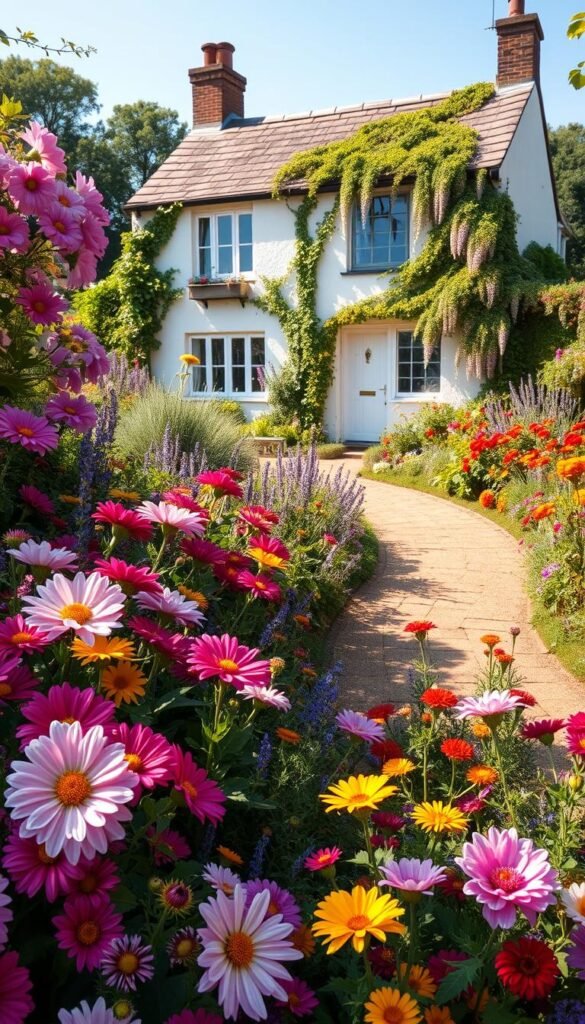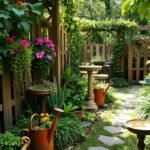Imagine stepping into a lush garden where flowers burst with energy like confetti at a summer celebration. This is the heart of cottage-style gardening—a living tapestry woven with carefree charm and strategic design. Unlike formal landscapes, these spaces thrive on joyful disorder, blending textures and heights to create depth that evolves with every season.
At its core, this approach celebrates abundance without overwhelm. You’ll layer plants so something’s always blooming, whether it’s fragrant roses in June or fiery asters in September. The magic happens when you pair classic cottage garden ideas with daring color combinations—think sapphire delphiniums dancing with golden marigolds, or ruby poppies winking through silvery lamb’s ear.
Successful designs balance spontaneity with smart planning. Tall foxgloves might anchor the back of a bed, while creeping thyme softens path edges. Mid-height blooms like cosmos and zinnias fill the space between, creating that signature “organized chaos.” Remember: even wild-looking plantings benefit from considering sunlight patterns and growth habits.
Modern twists on this tradition let you personalize the palette while keeping its soul. Maybe you’ll mix jewel-toned salvias with pastel lupines, or let deep purple verbenas cascade over a weathered fence. The goal? A space that feels both timeless and unmistakably yours—a living portrait painted with petals and passion.
Understanding the Cottage Garden Aesthetic
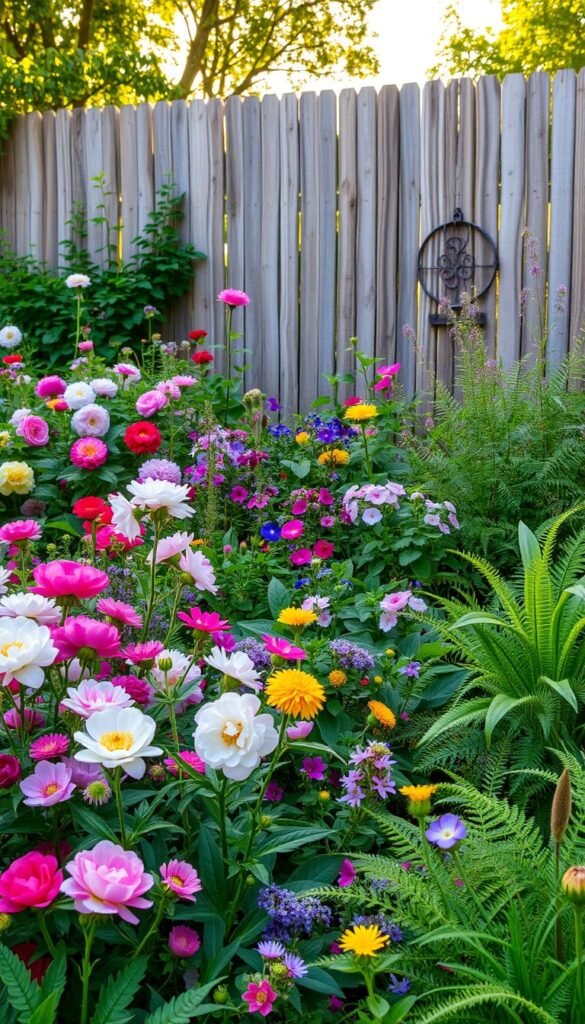
Think of a garden that feels like a warm embrace from nature itself. These spaces thrive on relaxed beauty, where plants mingle freely yet harmoniously. Designer Emily Smiley puts it best: “It’s about crafting a living poem where romance meets practicality—structured enough to delight, wild enough to surprise.”
Defining the Cottage Garden Style
This approach blends curated elegance with joyful chaos. You’ll see foxgloves reaching skyward beside feathery cosmos, while thyme spills over stone paths. Edible herbs like lavender mingle with peonies, proving beauty and function coexist effortlessly.
Key Elements: Layers, Textures, and Natural Charm
Vertical drama comes from hollyhocks or climbing roses, while daisies and catmint fill mid-level gaps. Letting flowers self-seed creates delightful surprises—a poppy here, a columbine there. Crushed gravel walkways and weathered benches add rustic textures, inviting you to linger among the scents and sights.
Choosing Bold Colors for Your Garden Design
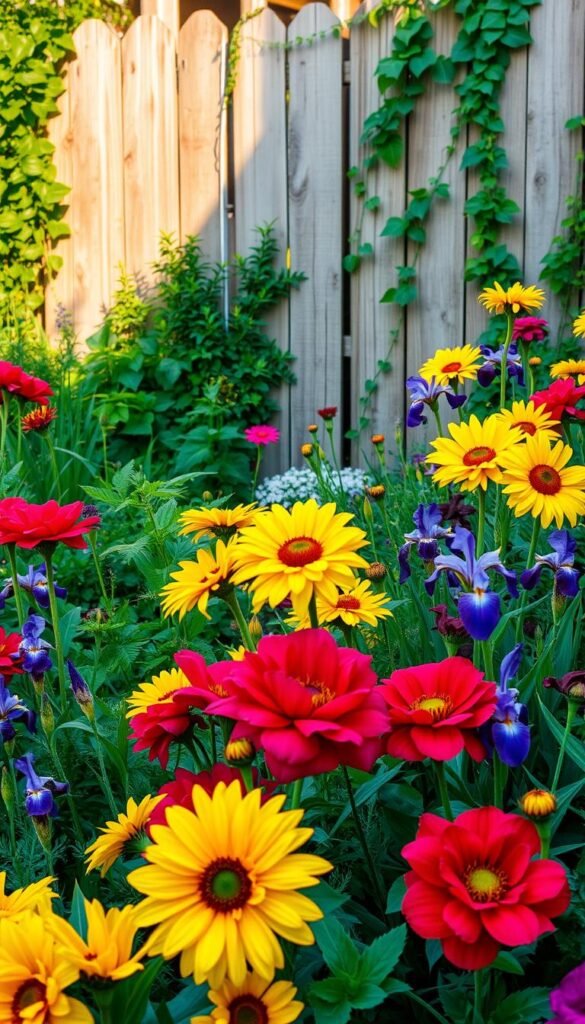
Picture a painter’s palette come to life—dabs of saturated tones dancing between greenery. This energy defines cottage gardens, where strategic color combinations create rhythm without rigid patterns. The secret lies in balancing excitement with cohesion, using nature’s own rules to guide your choices.
Exploring Vibrant Hues and Complementary Combos
Opposites attract in the best way here. Pair fiery marigolds with cobalt delphiniums, or let sunny coreopsis pop against violet salvias. These high-contrast duos work like exclamation points—perfect for framing gates or highlighting mixing vintage and modern elements in your layout.
Using Analogous and Monochromatic Palettes
For serene corners, try neighboring hues on the color wheel. A pink-to-purple progression with roses, lupines, and catmint feels effortlessly unified. All-white spaces shine too—mix snowdrop anemones with creamy peonies for moonlight magic after dusk.
Integrating Color Theory into Outdoor Spaces
Notice how golden hour intensifies warm tones, while midday sun softens pastels. Position ruby poppies where sunset glows through their petals. Repeat key colors along pathways to guide the eye, creating visual threads that tie your design together.
Your garden becomes a living canvas where every season introduces new shades. Start with one bold pairing, then let nature—and your personality—fill in the rest.
How to Achieve a Cottage Garden Aesthetic with Bold Color Choices
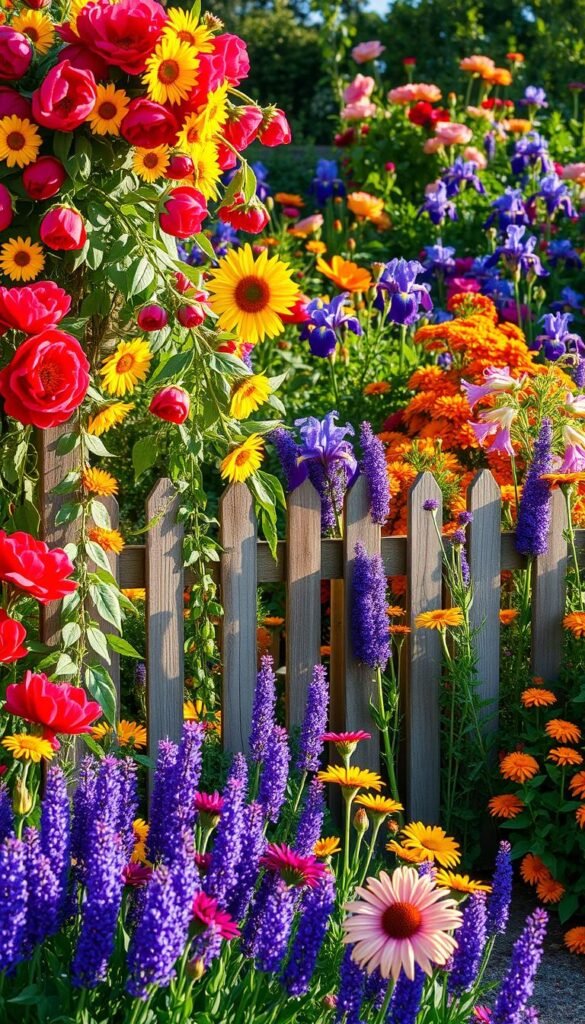
Transform your outdoor space into a living masterpiece by borrowing techniques from interior design. “Your garden should feel like your favorite room—only with better air circulation,” laughs designer Emily Smiley. This approach blends personal style with nature’s rhythms, creating spaces that delight through every season.
Mastering Chromatic Harmony
Start by identifying your anchor hue—the color that makes your heart sing. Nancy Ondra suggests looking at your wardrobe or home decor for inspiration. A cobalt-loving designer might pair delphiniums with buttery coreopsis, while sunset enthusiasts could mix peach dahlias with magenta phlox.
Consider these dynamic combinations:
| Dominant Hue | Complementary Plants | Bloom Period |
|---|---|---|
| Royal Purple | Salvia, Allium, Iris | Late Spring-Fall |
| Sunset Orange | Marigold, Helenium, Geum | Summer-Frost |
| Lemon Yellow | Black-Eyed Susan, Rudbeckia, Goldenrod | Mid Summer-Fall |
Pay attention to foliage’s supporting role. Silver artemisia cools fiery blooms, while burgundy heuchera leaves deepen pink peonies. Smiley advises: “Treat leaves as velvet curtains framing floral stars.”
Time your choices like a symphony conductor. Early tulips pass the baton to June roses, while autumn asters take center stage as summer blooms bow out. This strategic approach ensures your color story unfolds chapter by chapter.
Remember—light transforms colors. Test swatches by observing plants at dawn, noon, and dusk. That crimson poppy that glows at sunset might disappear in midday glare. Your garden becomes a daily surprise when you master these designer tips.
Integrating Bold Color Choices into Your Planting Strategy
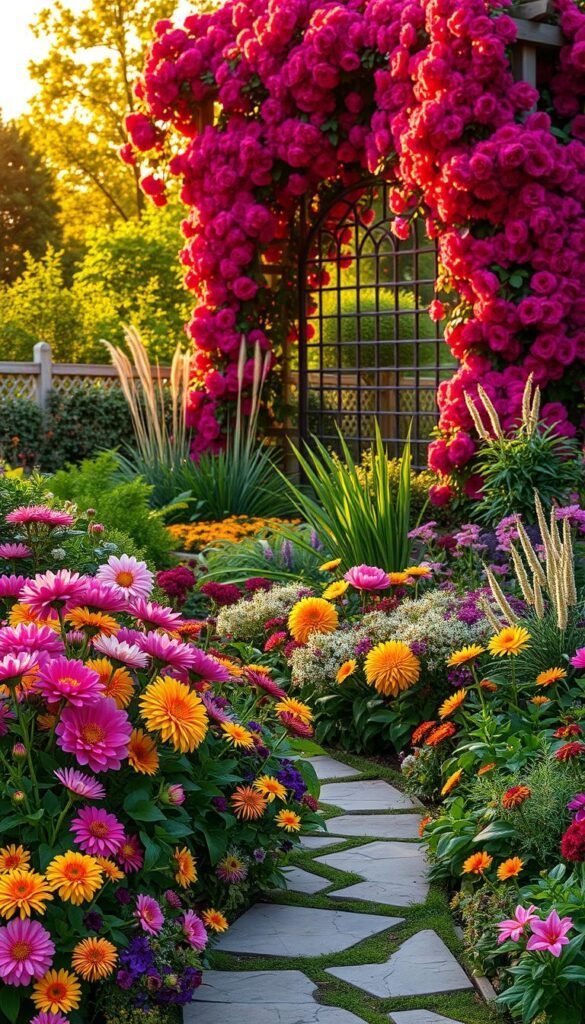
Visualize a living quilt where every stitch represents a carefully chosen plant. Your garden becomes a dynamic display when you plan for nonstop vibrancy from spring’s first sprouts to autumn’s final hurrah.
Layering Plants for Continuous Bloom
Build your garden in three tiers like nature’s own theater. Tall performers like hollyhocks and sunflowers form the backdrop, their bold heads nodding in the breeze. Mid-height flowers—lavender’s purple spikes or zinnias’ confetti-like petals—fill the stage with summer-long energy.
| Layer | Key Plants | Bloom Period |
|---|---|---|
| Vertical Backdrop | Foxgloves, Sweet Peas, Delphiniums | Late Spring-Fall |
| Mid-Level Stars | Cosmos, Daisies, Hydrangeas | Summer-Frost |
| Groundcover Crew | Pansies, Lamb’s Ear, Creeping Thyme | Cool Seasons |
Incorporating Edible Elements and Fragrant Herbs
Rosemary’s spiky blue blooms pair perfectly with ruby-red patio tomatoes. Basil’s glossy leaves contrast with frilly marigolds, while lettuce forms emerald rosettes between pansies. These edible accents work double duty—feeding both eyes and appetite.
For fragrance, plant lavender along paths where brushing releases its scent. Catmint softens bed edges while attracting pollinators. This mix of beauty and function keeps your garden buzzing with life throughout the growing season.
Even small spaces shine with this approach. Try patio container gardening using dwarf fruit trees as vertical elements, herbs as mid-layer fillers, and strawberries as edible groundcover.
Designing Your Garden Layout and Color Flow
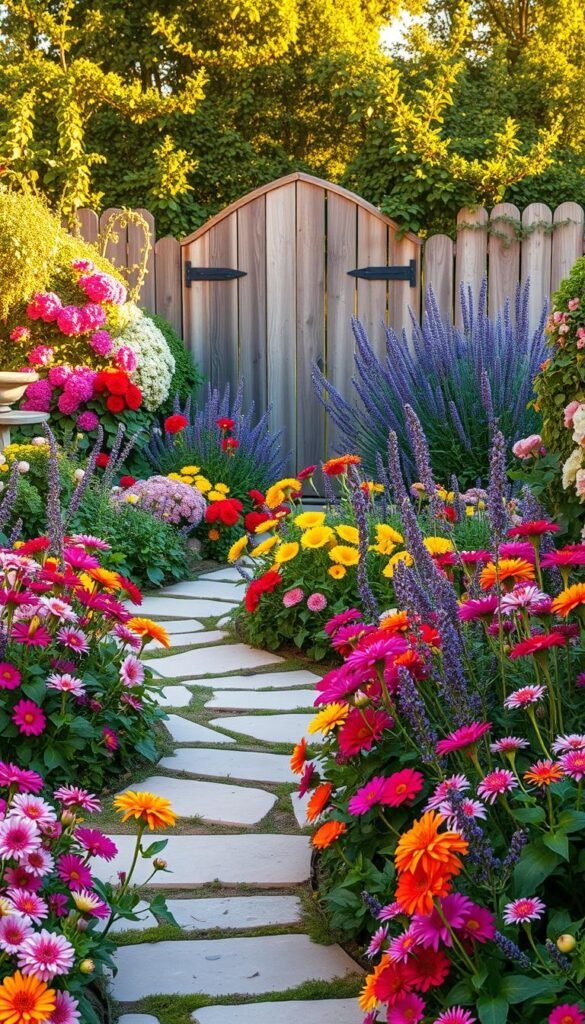
Picture pathways that curl like ribbons through vibrant blooms, tempting visitors to wander and wonder. This organic flow defines cottage-style spaces, where every turn reveals new delights—a weathered bench here, a cluster of ruby poppies there. Your layout becomes a storybook with chapters unfolding through seasonal textures and hues.
Creating Meandering Paths and Focal Areas
Ditch straight lines for curving trails made of crushed shells or reclaimed bricks. These winding routes slow the pace, letting guests savor your garden‘s details. Place a vintage wheelbarrow overflowing with petunias at a bend, or nestle a stone birdbath among foxgloves. Designer Emily Smiley notes: “Focal points work best when they feel discovered, not staged.”
Balancing Tall Blooms with Groundcover Textures
Let towering hollyhocks frame your space like living columns, then soften their bases with silver lamb’s ear. Creeping thyme spills over edges, blurring boundaries between planted areas and pathways. This layering creates depth—tall spires catch sunlight while low-growing foliage adds velvety contrast underfoot.
Upcycle old ladders as vertical planters for sweet peas. Their delicate blooms will cascade downward, meeting upward-climbing nasturtiums halfway. In smaller yards, use dwarf fruit trees as natural arches. Their spring blossoms and autumn fruits add multi-season charm while guiding the way through your floral narrative.
Practical Garden Tools, Soil, and Watering Tips
Like a chef prepping their kitchen, your garden thrives when you start with quality ingredients. Healthy soil and smart watering habits create the foundation for vibrant blooms that last through seasons. Let’s dig into essentials that keep your space thriving year-round.
Testing Soil, Composting, and Mulching Strategies
Test your soil first—it’s like getting a recipe right before baking. Local cooperative extensions offer professional analysis for under $20, revealing pH balance and nutrient gaps. Feed your earth with homemade compost from kitchen scraps or enriched blends like Coast of Maine’s lobster compost.
Mulch works overtime in your beds. Shredded leaves suppress weeds while decomposing into rich humus. This natural blanket protects roots during summer heat and winter chills, keeping soil active throughout the year.
Watering Techniques for Deep, Nourishing Hydration
Water deeply at the plant’s base—think slow sips rather than quick splashes. Morning sessions reduce evaporation and prevent soggy leaves that invite disease. For container plants, check soil daily in summer; small pots might need two drinks during heatwaves.
Smart tools make care easier. Soaker hoses deliver moisture directly to roots, while self-watering pots help busy gardeners. Pair these with moisture-retentive mulch, and your home oasis stays lush even when life gets hectic.

